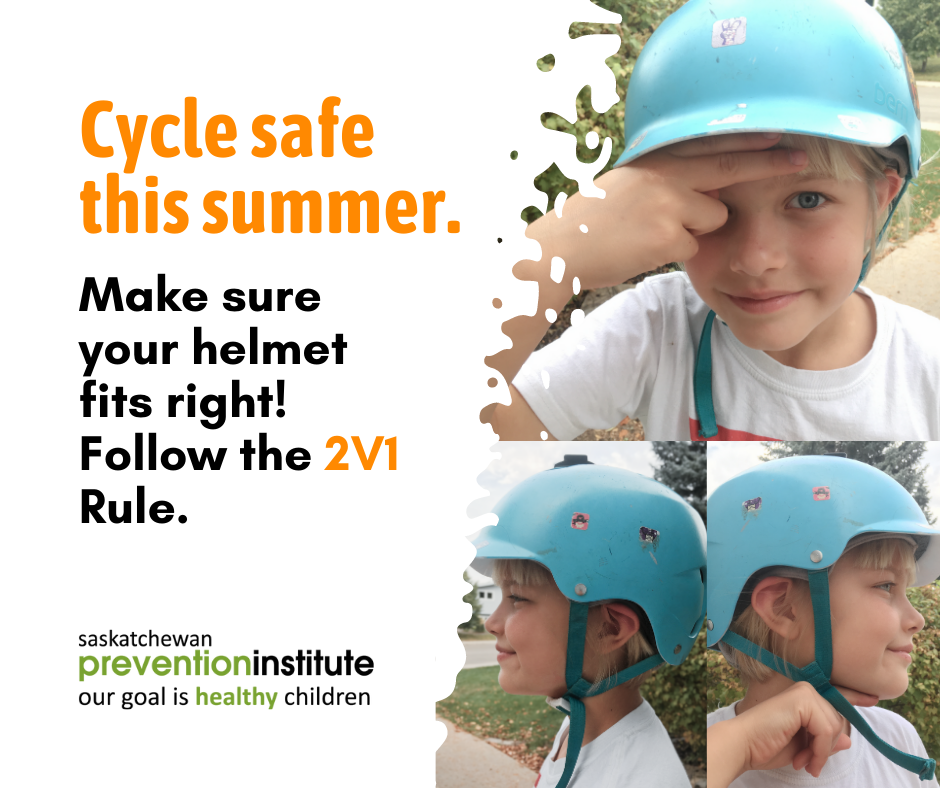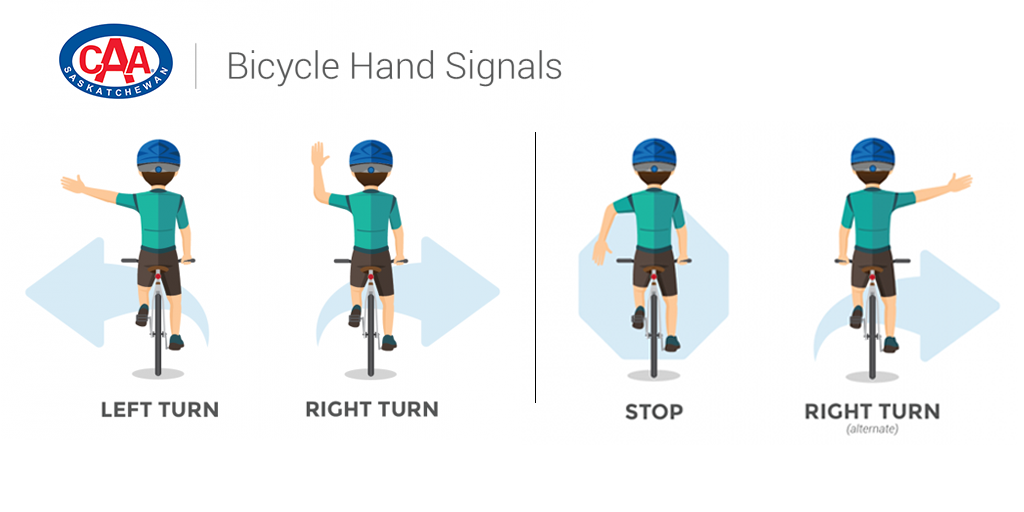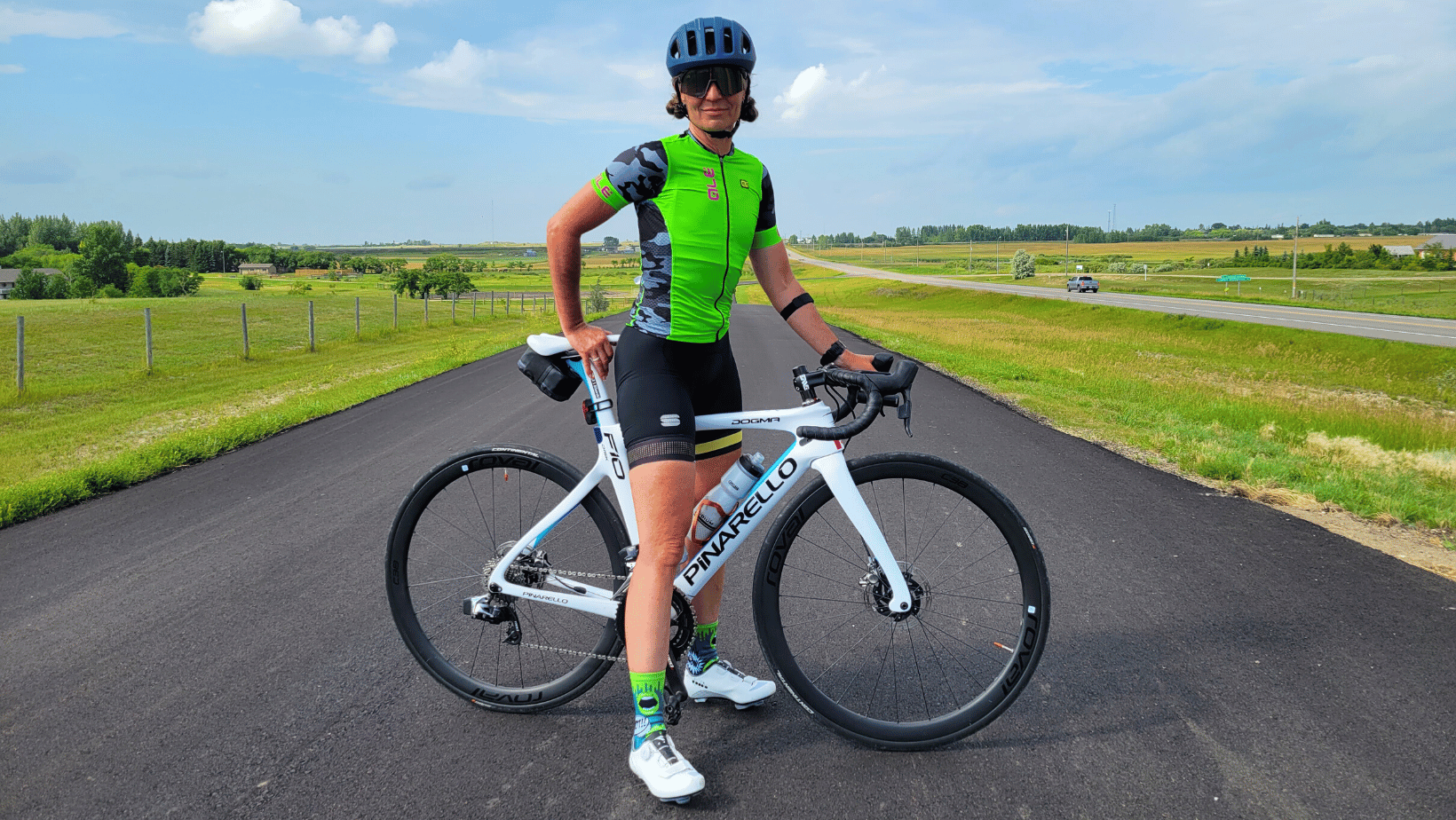Meet Sarah Bilawski.
An avid cyclist, Sarah, travels approximately 17,000 km per year (combined outdoor and indoor cycling).
She started cycling in 2019 to increase her overall aerobic strength when she was part of a dragon boat team. During the pandemic, the team was unable to paddle so she switched to cycling to stay active.
Sarah commutes to work, goes shopping, and runs most of her in-town errands on her fixie, a fixed-gear bicycle. In the spring, she rides gravel while the roads are still messy from winter.
Summer’s focus is road cycling, and she prefers long-distance (100+ km) events/races. Fall is great for cyclocross, which combines road racing fitness with off-road skills.
One of her favourite group riding opportunities is in the winter with fat bikes through Wascana Park in Regina. When it’s too cold to ride outside, Sarah rides her trainer (stationary bike).
She’s ridden every day since March 13, 2020, and says it’s become this crazy little streak that she can’t seem to stop. “The benefits of cycling are plentiful,” explains Sarah.
“It’s great for your physical and mental health, as well as the environment, and it saves your money. When you cycle, you become part of an amazing community of people. There’s always someone new to meet and share stories.”
Always be prepared before heading out
Sarah says good outdoor clothing is imperative when it comes to cycling.
In the winter, you need to stay warm and dry, so you don’t freeze. In the summer, you need to plan routes where you have access to water and be cautious of heat stroke.
One must check the weather for the probability and unpredictability of summer thunderstorms.
She also spends a fair amount of time maintaining her bikes.
It’s important they are in good working condition. She carries a flat tire repair kit. She checks her tire pressure, ensures her lights are charged up and working, and checks the weather forecast.
If she’s going out on a longer ride, she brings adequate water and food. She carries her cell phone, charger, and her identification in case of emergency.
If she’s riding longer distances, and going solo, she always lets someone know her intended route and when she expects to be home.
Sarah says it’s important to be safe while you ride and recommends a review of CAA’s bike safety advice.
CAA’s Top 10 bicycle safety tips
Whether you ride for leisure, to get to work, or you are a serious year-round cyclist, it’s important to consider all aspects of safety from bike maintenance to sharing the road with others.
When purchasing a bike, consider the size, frame, seat height, and the type of trails you ride. It’s important to ensure your bike is in good working condition by performing some bike maintenance.
Here are our top 10 bicycle safety tips.
1. Check the tires
Proper tire maintenance is crucial for a safe and enjoyable ride. Take a moment to check the pressure on your tires, ensuring they are inflated to the recommended level for optimal performance.
Additionally, inspect the condition of your tires, looking out for any signs of wear, cracks, or gouges.
Addressing these issues promptly will help prevent potential mishaps on your cycling adventures and ensure a smooth and worry-free journey.
CAA Rewards® partner and locally owned Saskatoon bike shop, Bruce’s Cycle Works, partnered with CAA Saskatchewan offering some Before You Bike Safety Tips.
SAVE 10% on all regular priced parts and accessories at Bruce’s Cycle Works!
2. Check the brakes, bar, & bells
Ensuring the proper functioning of your bicycle is vital for a safe and smooth ride. Check your brakes and the brake pads, ensuring they are in good condition and provide adequate stopping power.
Additionally, set your handlebar to the correct height to promote comfortable and efficient steering.
Remember, communication is key on the road, so make sure your bicycle is equipped with a working bell or horn to alert fellow cyclists when approaching or passing.
However, it's important to note that while bells are effective for signaling to other cyclists, they may not be loud enough to capture the attention of car drivers.
Therefore, it's crucial to utilize both a bell and hand signals to communicate your intentions to all road users, fostering a safer and more harmonious biking experience.
3. Check the chain and crank
Maintaining a well-functioning bicycle is essential for a smooth and enjoyable ride. Pay attention to your chain, ensuring it is properly lubricated and securely in place.
A well-oiled chain helps prevent unnecessary friction and keeps your bike running efficiently.
Additionally, check the crank to ensure it moves smoothly through its gears, allowing for seamless transitions between different speeds.
A properly functioning gear system is crucial for a comfortable ride and optimal performance. Take the time to test and adjust your bike's shifting mechanism, ensuring it shifts gears easily and cleanly.
4. Add the proper lights
Visibility is crucial when riding your bike, especially during nighttime or in unfavorable weather conditions. To ensure your safety, it is important to have proper illumination on your bicycle.
Attach a white light to the handlebars or the front of the frame, illuminating the path ahead. Additionally, add a red rear light and reflector to enhance your visibility from behind.
These lights will make you more noticeable to other road users, reducing the risk of accidents and providing a safer riding experience.
By prioritizing proper bike illumination, you can ride with confidence, knowing that you are doing your part to promote visibility and keep everyone on the road safer.
5. Wear a proper helmet
You should always wear a helmet when you ride your bike, scooter, skateboard, roller skates, ATV, motorcycle, etc.
For cycling, the helmet should be a properly fitted, approved bicycle helmet (from the Canadian Standards Association, Consumer Product Safety Commission, Snell, or American Society for Testing and Materials).
To ensure the right fit, for your bike helmet follow the 2V1 rule demonstrated on the Saskatchewan Prevention Institute website. The helmet rim should sit two finger widths above the eyebrows.

Ensure the straps form a V under the ears. One finger should fit between the chin and chin strap.
The helmet is designed for a single impact, so you should replace your helmet once you’ve been in a hard fall or collision.
6. Wear proper clothing
Wearing proper gear is essential for both comfort and safety during your cycling or running adventures.
Invest in proper running or cycling shoes that provide the necessary support and grip, ensuring a comfortable and secure fit.
Opt for fitted pants or leggings that won't get tangled in the chain, reducing the risk of accidents or mishaps. Additionally, consider adding reflective tape to your clothing, helmets, and bikes.
This simple yet effective addition enhances your visibility, especially in low-light conditions, making you more noticeable to other road users.
Shea from Bruce’s Cycle Works shares some advice on how to Be Seen, Be Ready, and Be Heard
Use your CAA membership for bike assist if you get stranded with a flat tire or a broken chain!
7. Share the road, share the responsibility
We each have a part to play in keeping each other safe. Driving is more than just a two-way street—roads are busy with pedestrians, motorcycles, scooters, bicycles, skateboards, rollerbladers, and e-bikes.
And there’s usually a lot of construction thrown into the mix, along with detours and traffic delays, as well as driver distractions.
Sarah agrees there is inherent risk in cycling but there are ways to be safer when riding.
There are many recreational cyclists not wearing helmets which, if worn, would help improve safety. It’s important we – motorists, cyclists, and pedestrians – all learn to work together.
Her biggest concerns are those which are out of her control.
Sharing the road with vehicles is always a bit stressful. Most motorists are or have been cyclists, and most adult cyclists also drive motor vehicles, according to Statistics Canada in a recent report.
The research also stated that, on average, 74 Canadians die in cycling collisions each year and 73 percent of those incidents involve a collision with a motor vehicle.
Distraction plays a role in many collisions. Check out CAA’s Share the Road videos to help motorists and cyclists share the road safely.
8. Motorists, learn to share the road
Sharing the road responsibly with cyclists is vital for everyone's safety. When encountering cyclists, always provide a safe distance of at least one meter between your vehicle and their bikes.
This allows them ample space to maneuver and helps prevent potential accidents.
Before making any turns, changing lanes, passing, or merging, be sure to check your mirrors and blind spots to ensure there are no cyclists in your vicinity.
Stay vigilant and avoid driving distracted, as distractions can impair your focus and reaction times, increasing the risk of accidents.
When parked on the street, don’t open your door into traffic. Instead, do the Dutch Reach and check your blind spot first. Watch the “Learn to do the Dutch Reach” video to learn the technique.
9. Cyclists, signal your intentions
Cycling responsibly ensures your safety and promotes harmony on the road. Avoid distractions while cycling, such as using headphones, as they can hinder your awareness of your surroundings.
Ride single file and stay on the right side of the road, in the same direction as the flow of traffic. This allows motorists to anticipate your movements and reduces the risk of collisions.
It's important to note that cycling on the sidewalk should be avoided whenever possible, as it can pose hazards to pedestrians and limit your visibility to drivers.
When approaching intersections, come to a complete stop, obey traffic signals, and yield the right-of-way to ensure a smooth and safe passage.
Use hand signals and let other cyclists, drivers, and pedestrians know what you are doing. Download the CAA Bike Safety Road Test for safe cycling tips and advice for families.
 10. Pedestrians, learn the rules of the road
10. Pedestrians, learn the rules of the road
Bicycles are considered by law, a vehicle on the road and they must obey the same rules. If you dismount and walk beside your bike you are considered a pedestrian and have the same rights as a pedestrian.
Use crosswalks and controlled intersections where possible. Put your cellphone and headphones away when crossing the street. Parents should teach their children the rules of the road.
The CAA Family Safety Booklet, available online and at all CAA Stores including the Regina Battery Depot, contains fun activities and information about pedestrian, bike, and school zone safety, as well as the CAA School Safety Patrol® Program.
Saskatchewan’s 10 best bike trails
Here are Sarah’s favourite bike trails, plus a few more that we’ve added to include locations throughout SK. CAA Members SAVE up to 10% when pre-purchasing a Parks Canada Discovery Pass at any CAA Store.
1. Sarah’s favourite gravel routes are in the valley near Lumsden. 7 Bridges is a must-see and close to Regina. Fat biking on the creek from Lumsden to Craven is a great way to see the valley from a new perspective. Her preferred road route is a 100+ km ride that includes the Fort Qu’Appelle, Pasqua Beach, Echo Beach, Katepwa Beach, to Taylor Beach loop.
2. Wascana Lake/Regina and area urban trails are scenic, level, and an easy bike ride. There are many different routes ranging from over 1 km to over 5 km.
3. Near Saskatoon, Meewasin Trail is a lengthy 105-kilometre trail that lives up to its name—meewasin is nêhiyawêwin (Cree) for “It is beautiful.” It starts at the Remai Modern and winds along the banks of the South Saskatchewan River to Wanuskewin Heritage Park (16.5 km one way).
4. Blackstrap Provincial Park, 30 minutes south of Saskatoon, features some of the best mountain bike trails around. There are 41 picturesque routes ranging from 4.6 km to 37.7 km jaunts.
5. Buffalo Pound Provincial Park offers mountain biking and fat biking trails. Tourism Saskatchewan offers this map with all the details including the elevations. The trails are rated novice, intermediate, and advanced and the distances are listed by the trail name.
6. Duck Mountain Provincial Park features rolling hills, lakes, and boreal forest. Bike part of the Trans Canada trail and throughout the park. Here’s a map of the route. Start where you want and end according to your desired length and skill level.
7. Prince Albert National Park offers relaxed pedaling on cycling paths in Waskesiu, road racing down Highway 263, or a more challenging mountain bike ride. Something for everyone!
8. Grasslands National Park features cycling trails on both the west and east block. Check out the challenging Broken Hills and Valley of 1,000 Devils trails.
9. Cypress Hills Interprovincial Park offers towering hills, lush forest, and wild prairies. They offer cycling for the entire family.
10. Lac La Ronge Provincial Park has approximately 120 km of trails for all ages and at different skill levels. Be sure to visit this charming northern community!
Discover more safety advice at caask.ca/bikesafety. Take care and have fun.

